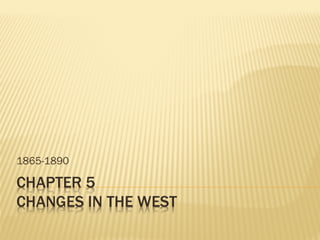
Chapter 5
- 1. 1865-1890
- 2. Land was communal – no one person or tribe could own land Buf falo was central to life
- 4. The buffalo were destroyed by settlers and tourists who shot them for sport
- 7. Viewed Native American land as unsettled Advanced to claim land Gold intensified the rush for land
- 8. 1834 – all of Great Plains set aside as “Indian Lands” 1850s – Policy shift – native get smaller amounts of land
- 9. Sand Creek Massacre – U.S. army attacks 150 native women and children killed
- 10. Colonel Custer and infantry reach Little Big Horn Crazy Horse and Sitting Bull lead Sioux tribe Outflank and crush Custer’s troops
- 13. December 1890- 7th Cavalry (Custer’s old regiment) rounded up 350 Sioux and took them to Wounded Knee, SD 7th Cavalry slaughtered 350 unarmed Natives The corpses were left to freeze
- 15. Attempted to assimilate natives Would break up reservations and introduce natives into American life – farming, etc By 1932 2/3rds of the land committed to Natives had been taken
- 17. After the Civil war the demand for beef rose sharply Urbanization and the rise of the railroad contributed to this Chicago Union Stock Yards
- 18. Thousands of cattle driven from Texas to Kansas Abilene, KS – place where trail met the railroads
- 19. Overgrazing, bad weather, and the invention of barbed wire led to the end of the cattle drive
- 20. Homestead Act – federal land policy Gave 160 free acres to any “head of household” Had to live on and farm land for 5 years
- 21. African Americans – moved from South to Kansas Took advantage of land deals in West
- 22. In a less than a day 2 millions acres of government land being given away was claimed by settlers Some took possession of the land before the government officially declared it open – thus Oklahoma became known as the “Sooner State”
- 23. Droughts, floods, fires, blizzards, locust plagues, bandits No neighbors nearby
- 24. Homes were built from the land itself Dug out of the sides of ravines or hills If land was flat made homes out of dirt
- 25. Despite these hardships, the number of people living west of the Mississippi grew from 1% of the nations population to 30% by 1900
- 26. 1837- John Deere steel plow – slice through heavy soil 1847 – reaper – invented by Cyrus McCormick
- 27. More people moved west and the railroads were born Government gave land grants to the railroads to help it grow
- 28. Completed in 1890 with help from Chinese workers
- 29. The Morrill Acts of 1862 and 1890 gave federal land to states to help finance agricultural colleges
- 30. In the late 1800s, many farmers were struggling Crop prices were falling, debt increased Mortgages were being foreclosed by banks
- 31. Between 1867 and 1887 the price of a bushel of wheat fell from $2.00 to 68 cents Railroads conspired to keep transport costs artificially high Farmers got caught in a cycle of debt
- 32. 1867 – Oliver Hudson Kelley - Grange Fought for farmer’s rights
- 33. Populism – the movement of the people – 1892 – Populist Party started THIS POLITICAL CARTOON SHOWS A POPULIST CLUBBING A RAILROAD CAR
- 34. economic - increase money supply (bimetallism - gold and silver standard), a rise in crop prices, lower taxes, a federal loan program Political - direct election of senators, single terms for presidents for an 8-hour workday and reduced immigration
- 35. In the 1892 Presidential election, the Populist candidate won almost 10% of the vote In the West, the party elected 5 senators, 3 governors and 1,500 state legislators James B Weaver
- 37. The central issue of the 1896 Presidential campaign was which metal would be the basis of the nation’s monetary system Bimetallism (those who favored using both) vs. those that favored the Gold Standards alone
- 38. Republicans favored the Gold standard and nominated William McKinley Democrats favored Bimetallism and nominated William Jennings Bryan Despite Bryan’s stirring words, “You shall not crucify mankind upon a cross of gold,” McKinley won the 1896 election BRYAN’S CROSS OF GOLD SPEECH
- 39. With McKinley’s election victory, Populism collapsed, 2 Legacies 1) the downtrodden can organize and be heard and 2) An agenda of reforms, many of which would be enacted in the 20th century THE PEOPLE’S PARTY WAS SHORT-LIVED BUT LEFT AN IMPORTANT LEGACY